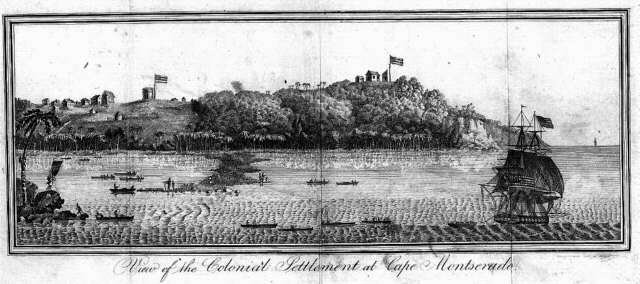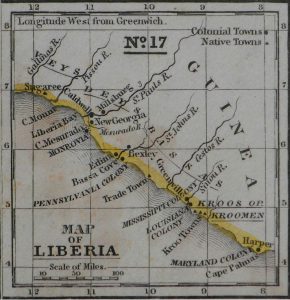Colony at Cape Montserrado
The freed slaves moved from Dozoa Island to Cape Mesurado to break free from harassment by the natives. In time, they would be called settlers, colonists and pioneers. As they had done on the island, they began building huts and making gardens. Eli Ayres went to Washington needed help, and the Brig Strong arrived in August with food, medication, clothing and other supplies. Among its passengers were Jehudi and Mary Ashmun, Negro preacher Lott Carey and 55 freed slaves.

Source: Wikipedia
Those early days proved very difficult for the settlers and many, including Ashmun’s wife, died because they had no resistance to the African fevers. They struggled for safe drinking water and often fought with the natives including the Bassas, Deys, Condos and Golas (Morrow, 1971).
Eventually, the colony began taking shape. They set up a marketplace where they could buy and trade goods with the natives. Other freed slaves from the Americas joined the settlement and captured freed slaves from slave ships on the Atlantic were also brought to the settlement.
The colony’s first leader was Ayres, and Elijah Johnson acted in Ayres absence. While Johnson focused on defending the settlers, Ashmun assumed leadership of the settlement. Upon Ayres return as the official Agent of the ACS, he resumed leadership. Ayres fell ill and went to London, and Ashmun was once again in control of the settlement. He then focused on establishing a form of government and order, establishing an advisory council to oversee the colony.
Ashmun had named the settlement Christopolis. He was later uncomfortable with the name and urged the Board to change it. On February 24, 1824, the settlement was renamed Monrovia in honor of US President James Monroe. This was recommended by General Robert Goodloe Harper, who also suggested naming the colony Liberia, which means ‘land of the free’ in Latin.

Source: Wikipedia
By 1825 the colony had expanded with settlements like Caldwell and New Georgia along the St. Paul River. Ashmun and Gurley (secretary general of the Society who arrived in 1825) created a constitution for the colony and had the settlers vote on it.
Lott Carey and the other settlers adapted the farming methods of the indigenous, growing their own food as they were always encouraged to be self-sufficient. They also started building schools for their children. There was also an emergence of black leaders at the colony including Lott Carey, Anthony Williams and Joe Roberts.
The colony’s roster of 1826 had roughly 40 families at or near Cape Mesurado, 33 in New Georgia, 77 in Caldwell, and 20 in Christopolis (Morrow, 1971). Basically, the colony at Montserrado was an extension of the ACS on the West African Coast. In the US, the ACS focused more on church affiliations and creating the state auxiliary organizations.
The state colonization societies became active in transporting their freed slaves and establishing their own distinct colonies on the Grain Coast. Together, the New York and Pennsylvania State Societies established the colonies at Bassa Cove and Edina.
The Maryland Colonization Society established Maryland in Liberia (now Maryland County) in 1834 at Cape Palmas. Dr. James Hall, representing the Maryland Colonization Society, bought this land from King Parmah of Cape Palmas, King Baphro of Grand Cavally and King Weak Bolio of Grahway.
Mississippi in Africa (now Sinoe County) was founded by the Mississippi and Louisiana State Organizations in 1838. The first settlers in this area arrived under the leadership of Josiah F. C. Finley, the son of Robert S. Finley who founded the ACS.
… it is hardly necessary to point out that the primary object of the several American Colonization Societies was not to abolish slavery as an institution, but to deport free Negroes. Slavery was then firmly established in America, and it was considered that its abolition was a very far distant event. The free Negro was not welcomed in the South, for he presented a problem of the equality of the white and black races. Indeed, in many sections, these Negroes were considered a menace to society, and an attempt at a general black man’s uprising was feared. For this reason, some authorities consider that the work of the colonization societies was not only a work of philanthropy, but also of precaution.
-Walker
Sources
Cassell, Abayomi. Liberia: History of the First African Republic. New York. Fountainhead Publishers, 1970. Print.
“First Annual Report of the American Society for Colonizing the Free People of Color of the United States.” N.p., American Colonization Society, 01 Jan. 1818. Web.
Gurley, Ralph Randolph. Life of Jehudi Ashmun, Late Colonial Agent in Liberia : With an Appendix, Containing Extracts from His Journal and Other Writings : With a Brief Sketch of the Life of the Rev. Lott Cary. Leavitt, Lord, 1835.
Kapuściński, Ryszard. The Shadow of the Sun. 1st ed. New York: A.A. Knopf, 2001. Print.
Latrobe John H. B. Maryland in Liberia. Maryland Historical Society. 09 Mar. 1885. Print.
Liebenow, J. Liberia : the Quest for Democracy. Bloomington: Indiana University Press, 1987. Print.
Richardson, Nathaniel R. Liberia’s Past and Present. Diplomatic Press and Pub. Co., 1959. Print.
The Monthly Miscellany of Religion and Letters. Vol. VI. Boston: William Crosby and Company. 1842.
Walker, Thomas B. History of Liberia. The Cornhill Publishing Company, Boston. 1921. Print.
Wilson, Charles Morrow. Liberia: Black Africa in Microcosm. [1st ed.]. Harper & Row, 1971. Print.
Visits: 166